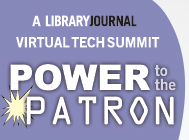 As part of the preparation for the upcoming LJ Virtual Tech Summit on December 8, The Digital Shift is featuring interviews with some of the panelists.
As part of the preparation for the upcoming LJ Virtual Tech Summit on December 8, The Digital Shift is featuring interviews with some of the panelists.
LJ talked to Gretchen Caserotti, assistant director for public services at Darien Library, CT, and a 2010 LJ Mover & Shaker, about self-service at Darien Library.
LJ: You have often used technology as a way to improve services at Darien, as in the “Little Clickers” class for preschoolers, or smartphones for staff so they can answer questions away from the reference desk. What self-service technologies are available at Darien? How do they fit into the library’s highly touted “extreme customer service” strategy?
Caserotti: Both our 3M self-checks and the Lyngsoe self-returns that are married to an automated materials handling system are the cornerstone of our service model. Eighty-five percent of checkouts are completed at the self-checks—thus freeing up staff members to provide Readers’ Advisory services to more patrons. Essentially all returns come through the materials handling system, including 40 percent in an outside drive-up return—thus smoothing the flow of returns, allowing us greater productivity in re-shelving, and freeing up staff for more value-added services to our members. Measurably, this is what I would call a great self-service success story.
I believe, in the same way, our reorganized, nontraditional print collections are also great successes in making the library self-serve. Browsers are the more difficult user group to serve and by making our picture book and nonfiction collections more browseable, we invite our members to discover more materials on their own. We are also envisioning ways that our patrons can be involved in the selection of our print materials—which could be considered the ultimate self-serve function—but it’s not something we’d be comfortable discussing just yet.
Darien recently unveiled an unusual service option: an Espresso Book Machine (EBM). Though not strictly a self-service technology, as patrons will be assisted in using the machine, the EBM also can empower patrons to self-publish their own work. What has been the reaction to the EBM so far?
The reaction to the EBM announcement has been wonderfully positive. Young children are thrilled to see a book being made right before their eyes. Adults are curious and asking lots of questions. We’ve had publishers from New York visit to have demonstrations, as well as local libraries contacting us to arrange visits. To say we are excited for our launch on November 15 is an understatement.
What trends in self-service do you think will gain momentum in the near future?
We all see the numbers of patrons coming to us with their handheld devices (smartphones, tablets) in our libraries. I expect the demand for mobile apps and sites will reach a tipping point, and I hope that libraries will embrace the possibilities for self-check to happen in the stacks on our own devices.
 Library Journal’s one-day Virtual Tech Summit on Dec. 8, Power to the Patron: From Systems to Services, will examine technologies that empower library users and the behind-the scenes systems that make them possible. Get more information and register at www.thedigitalshift.com/events/tech-summit/.
Library Journal’s one-day Virtual Tech Summit on Dec. 8, Power to the Patron: From Systems to Services, will examine technologies that empower library users and the behind-the scenes systems that make them possible. Get more information and register at www.thedigitalshift.com/events/tech-summit/.

